MIPLM 2017-18 — 4th module on IP management organization and case study presentations
The organization of IP management within companies and between companies and service providers is a crucial success factor for innovation management. In the 4th module of the MIPLM in IP management, the participants were taught about the relationships between institutional economics and organizational structures, how context-dependent organizational structures are, and how IP management an IP departments should be organized in line with different objectives. In addition, different approaches to influencing staff behavior and actions were discussed. Within the theoretical framework of institutional economics, the students learned how to analyze and optimize organizational forms such as cooperations, contracts, licensing relationships, projects, or departments in practice. Through different case studies (SAFRAN, Philips, Procter & Gamble, Infineon, ThyssenKrupp, and Volvo), the participants were taught how to apply the theoretical approach to real-life cases for successful IP management.
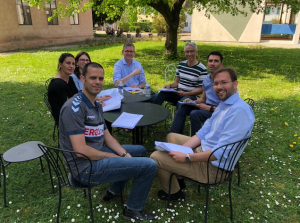 In the 4th module, the students applied property rights theory, transaction cost theory, and agency theory to common challenges of IP management work, outsourcing of IP work, negotiating licensing contracts, or organizing IP work for different business units or different divisions within a company. They learned how to integrate the strategic background from the 1st module with the market- and resource-based views, and the risk management perspective from module two, as well as the definition of innovation management and innovation marketing from the 3rd module. The students gained an understanding of how modern IP management is organized in IP departments in the form of centers, including protection centers, differentiation centers, profit centers, and asset centers. In addition, they learned how to structure portfolios for business model implementation by applying effectiveness and efficiency criteria.
In the 4th module, the students applied property rights theory, transaction cost theory, and agency theory to common challenges of IP management work, outsourcing of IP work, negotiating licensing contracts, or organizing IP work for different business units or different divisions within a company. They learned how to integrate the strategic background from the 1st module with the market- and resource-based views, and the risk management perspective from module two, as well as the definition of innovation management and innovation marketing from the 3rd module. The students gained an understanding of how modern IP management is organized in IP departments in the form of centers, including protection centers, differentiation centers, profit centers, and asset centers. In addition, they learned how to structure portfolios for business model implementation by applying effectiveness and efficiency criteria.
Case Study on IP management organization
Case Study Background
Implementing a differentiation center
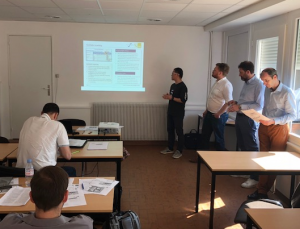 A revolutionary solution to automatically analyzing carb intake while eating
A revolutionary solution to automatically analyzing carb intake while eating
To keep blood-sugar levels within a healthy range, the body processes multiple, complex information from the brain, digestive system, and other sensory organs. The bodies of patients with T1DM, who suffer from a loss of their beta cells due to an autoimmune reaction, are no longer able to produce insulin. Early-stage patients with T2DM suffer from enhanced insulin-resistance, which can ultimately lead to a loss of their ability to produce insulin within their body. To bridge these shortcomings, the artificial pancreas (AP) promises a great contribution to patients’ perspective of leading a near-normal life again. These systems constantly measure the blood glucose level and automatically inject insulin when needed.
So far, the algorithms in the AP have been unable to process information on the exact amount and composition of the food the patient is consuming. The Smart Tooth adds this missing piece of information and closes the gap. Attached to patients’ teeth by a dentist, the Smart Tooth provides detailed information about food intake. As it is extremely important for diabetics to eat healthily and measure their carbohydrate intake, this solves an essential problem for patients. The Smart Tooth consists of a small spectroscope which analyzes carbohydrates, as well as a vibration sensor which track chewing and swallowing motions. Machine learning algorithms which take into account patients’ personal eating patterns are used to improve the accuracy of the computed amount of insulin required. The energy needed to power the Smart Tooth is produced by a piezoelectric element which simultaneously works as a pressure sensor. A small low-energy Bluetooth transmitter sends the data directly to the AP or another reception device 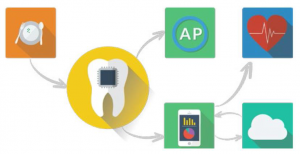 such as a bracelet. Finally, a mobile application visualizes the generated data. When thinking about the future of individual mobility today, we cannot ignore the idea of electromobility. The electromobility debate frequently revolves around drive systems and the likely moment at which electric drives will outstrip or indeed completely replace the combustion engine. But electromobility is a topic which requires systemic thinking, i.e. viewing the vehicle as part of an ecosystem. Electromobility must be understood as a holistic concept, from appealing vehicles, rapid charging, driving pleasure and autonomous driving to tailor-made mobility services, batteries, and power sources from renewable energies. But electromobility extends far beyond the vehicle. This ecosystem includes components as diverse as vehicles, power supply, and transport infrastructure, which must be networked and interlinked in order to enable sustainable mobility beyond established industrial sectors. The focus should always be on the users themselves and their mobility needs.
such as a bracelet. Finally, a mobile application visualizes the generated data. When thinking about the future of individual mobility today, we cannot ignore the idea of electromobility. The electromobility debate frequently revolves around drive systems and the likely moment at which electric drives will outstrip or indeed completely replace the combustion engine. But electromobility is a topic which requires systemic thinking, i.e. viewing the vehicle as part of an ecosystem. Electromobility must be understood as a holistic concept, from appealing vehicles, rapid charging, driving pleasure and autonomous driving to tailor-made mobility services, batteries, and power sources from renewable energies. But electromobility extends far beyond the vehicle. This ecosystem includes components as diverse as vehicles, power supply, and transport infrastructure, which must be networked and interlinked in order to enable sustainable mobility beyond established industrial sectors. The focus should always be on the users themselves and their mobility needs.
The accompanying mobile application provides a secondary revenue stream in addition to the Smart Tooth device itself and will be offered as a freemium model. Every patient receives a basic version with limited insight to the data, whereas the optional premium subscription model provides access to the full holistic functionality of the health platform.
As long as there is no cure for diabetes, this combined system will enable patients to take their minds off the disease and increase their quality of life by removing the strenuous obligations to measure glucose, manually inject insulin, and adjust their insulin-dose after having consumed a heavy meal.
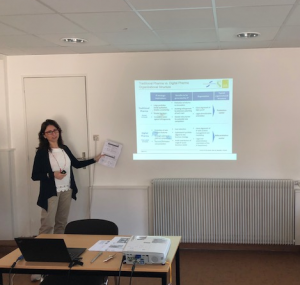 Key Partners
Key Partners
The most important key partners are AP manufacturers, who serve as customers, key partners, and distribution channels at the same time. As the Smart Tooth is not a mere standalone system but rather a supporting device for the AP, a strong partnership with AP manufacturers is of utmost importance. The focus lies on establishing a common ground for the technological exchange between the Smart Tooth and the AP. Furthermore, the algorithm and the API need to be integrated with the AP to enable the precise interpretation of the data provided by the Smart Tooth, and to implement machine learning algorithms.
In addition, as the Smart Tooth is a medical device for diabetics, expert knowledge and experience of physicians and diabetologists is very important for the success of the Smart Tooth. Most importantly, dentists and orthodontists, who will be installing the Smart Tooth, will have to be trained on how to install and maintain the Smart Tooth components.
Insurance companies are also important stakeholders, as their consent for reimbursement will have a huge impact on sales volumes and is closely related to the acceptance and success of the product. The Smart Tooth improves the treatment of diabetes and prevents costly follow-up diseases, which is an incentive for insurance companies to reimburse the installation and maintenance of the product.
Key Activities
A prerequisite for a successful medical device is the compliance with medical standards and the approval as a medical device. This requires prototypes to be tested for efficacy and effectiveness in clinical trials.
From a business operations point of view, the key activities are sales and marketing to doctors, hospitals, and insurance companies. The main goal is to achieve full reimbursement by insurance companies for most patients in order to ensure a large market potential. Therefore, presenting the technologies at conferences, both in a medical as well as a business context, is of great importance. Training sessions for doctors on the benefits, implementation, and maintenance of the product are likewise part of this important activity. Doctors must be trained in the correct usage of the device and educated about the mechanism of the Smart Tooth.
In addition, research and development (R&D) is key in order to continuously improve and adjust the product. This applies in particular to the required sensors and the algorithm-driven machine-learning aspects of the technology. The algorithm detecting eating habits and predicting the required insulin dose must be developed along with the Smart Tooth API. The interface must be designed in a way that allows it to interact with the algorithms of closed loop systems and other health applications. Finally, the visualization of the patient’s data within the Smart Tooth App needs to be engineered.
Ensuring a consistently high quality of the device and the analysis technique used have a huge impact on patient satisfaction and subsequently on business success. Closely related to this is the maintenance of the API to ensure an infallible interface between the Smart Tooth and the devices connected to it. Constant bug fixing, regular updates, and minor adjustments are part of the regular improvement activities. Alongside this, the purchase of the hardware components must be a focal point in operations due to the key relevance of price and quality for the business model. Consequently, maintaining good business relationships with trusted suppliers is necessary for preventing irregularities in terms of quality.
Key Resources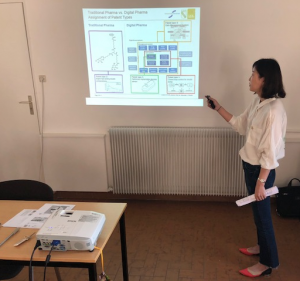
As a result of R&D activities and efforts required in order to constantly improve the system, the most important resource for the Smart Tooth is intellectual property. Protecting the Smart Tooth technology and brand is key for its commercial success. By patenting multiple aspects of the carbohydrate measuring technique, the business ensures the sustainable profitability of the technology developed. Another key aspect of intellectual property is that the advanced Smart Tooth technology will attract business partners, investors, and shareholders.
Before a medical device can be used on patients, it must be subjected to a number of clinical trials in order to prove its clinical effectiveness and efficacy. Having demonstrated its efficacy and increased quality of treatment, the Smart Tooth will become state-of- the-art medical practice. Lastly, the Smart Tooth relies on the knowledge and expertise of its employees. On the one hand, hardware developers are required for designing the Smart Tooth with its multiple sensors on a very small footprint. Their expert knowledge is also valuable for advising customers and partners on technical questions. On the other hand, software developers are needed in order to develop algorithms and interfaces for communication with other medical devices and smartphones. They are also in charge of the user-friendliness of the smartphone application and the visualization of the Smart Tooth data. Furthermore, a committed sales force and marketing team are required to sell the product to doctors, hospitals, and insurance companies.
Value Proposition
Invisibly installed on the back teeth inside a patient’s mouth, the Smart Tooth offers an accurate, user-friendly, and discreet way to measure the carbohydrates eaten. This revolutionizes diabetes self-management and significantly increases patients’ quality of life.
Combined with an AP, the Smart Tooth creates a comprehensive closed loop system. While the tooth assesses the amount of carbohydrates eaten, the appropriate dose of ultra-fast-acting insulin is automatically released into the body by the AP. This system offers two major improvements to existing diabetes management methods by extending the closed loop: 1) It measures the patient’s actual food intake instead of only estimating it. Consequently, the accuracy of measurement increases significantly compared to current methods such as patients manually assessing the amount of carbohydrates eaten or image-driven mobile phone applications; 2) No human intervention is necessary, as the data is sent directly to the AP. Common AP systems still require patients to manually adjust the insulin release before eating. This is due to a measurement delay caused by measuring the blood glucose level in the abdominal interstitial fluid. The simultaneous measuring of carbohydrates to their intake saves valuable time and allows the AP to swiftly adjust the insulin release accordingly. A more accurate measurement of carbohydrate intake inhibits unnecessary insulin injection and thus limits unnecessary feelings of hunger. This solves a widespread paradox: by dosing insulin incorrectly, patients tend to eat more, which often ultimately worsens their condition.
Patients’ fear of hypoglycemic events is a major issue in diabetes treatment. These can lead to dangerous and even fatal situations. As a consequence, many patients risk a slight, constant hyperglycemia to avoid those incidents. Since the long-term effects of excessively high blood glucose levels, such as blindness or acute microvascular disease, can be severe and cost-intensive, avoiding these follow-up diseases significantly increases patients’ quality of life. As a consequence of this perfected closed-loop-system, hypoglycemia and hyperglycemia can be effectively eliminated.
Customer Relationships
As the Smart Tooth shows, the device develops its greatest potential when it is embedded into an AP closed loop system, for which a close collaboration with the AP manufacturers is necessary. This not only matter during the development phase, but will also be highly relevant for sales and distribution later on. The goal is to get AP suppliers to offer the Smart Tooth as part of their own product range. A permanent and personal relationship with B2B partners fosters innovative cooperation and will help provide assistance in solving technical difficulties quickly.
Apart from keeping close contact with tech-companies, the ongoing exchange with physicians is also of central importance. As Smart Tooth deals with a highly specialized medical market, the company plans to publish its results in medical journals, and attend medical fairs, conferences, and diabetes conventions in order to raise awareness for the Smart Tooth.
The company also wants to make the patient, its end consumer, aware of the Smart Tooth. In addition to existing channels, an informative website and social media platform directly informs diabetics and health-conscious customers about the product. Patients can co-create the future of the Smart Tooth by giving feedback and suggestions to improve the measuring device and application. Customers who actively use the Smart Tooth app receive regular updates and information on company news and developments.
Channels
There will be a twofold strategy for selling the Smart Tooth hardware to customers. As with most medical devices, such as dental braces or sensory implants, patients cannot buy the device directly from the supplier. Instead, physicians procure them from the manufacturers and are subsequently reimbursed by insurance companies. In this respect, doctors prescribing the Smart Tooth will follow the conventional sales approach for medical devices. This represents the first sales channel for selling the Smart Tooth directly via physicians. To a large extent, the Smart Tooth can be sold as an extension to complement AP closed loop systems. In these cases, the AP manufacturer would buy the Smart Tooth and sell it to doctors and patients via their own channels. This would result in a large potential customer base provided by companies producing AP. Using the existing channels of these key partners makes market entry straightforward and saves costs. Support and service for the product are provided by dentists, who closely cooperate with the patients’ diabetologists. The goal is to achieve full recognition among experts and to be included in the medical guidelines for diabetes care. The goal of the sales channel is to convince diabetologists of the benefits of the Smart Tooth and to encourage them to recommend it to their patients.
The smartphone application will be available in major app stores. The basic version of the Smart Tooth mobile phone application comes free of charge with the Smart Tooth package. It will be available for download in the Apple and Google Play Store and can then be upgraded by the patient with an in-app purchase using the app stores’ payment methods.
Customer Segments
 Due to the multitude of stakeholders involved in the market for medical devices, the definition of the customer segments is multi-layered. On the one hand, the end user of the Smart Tooth, namely users of a perfected closed loop system, are diabetes patients whose quality of life and treatment will be significantly improved.
Due to the multitude of stakeholders involved in the market for medical devices, the definition of the customer segments is multi-layered. On the one hand, the end user of the Smart Tooth, namely users of a perfected closed loop system, are diabetes patients whose quality of life and treatment will be significantly improved.
Nevertheless, it is the physician who will decide on the treatment method to be used, which is why they will have to be convinced of the system’s benefits and effectiveness. Ultimately, the health insurance provider will pay for the product, which makes it necessary (and common practice) to approach physicians and insurance providers in order to promote the Smart Tooth system. The main benefit is the ability to provide improved treatment and lessen complications or follow-up diseases. Therefore, while patients are the end users, they are not the customers to be targeted. In addition, suppliers of AP systems can use the Smart Tooth and its API as an extension to complement their closed loop systems and therefore improve their products. Since they already benefit from developed sales channels, targeting them as customers and reaching their customer base as end users is very promising.
Patients are the direct customers for the premium subscription of the mobile phone application. As an optional extension of the Smart Tooth, the data collected will be analyzed to improve the patient’s understanding of their own dietary patterns. Physicians will only be involved indirectly if patients agree to share their data.
Cost Structure
The largest part of the fixed costs is R&D spending: for the hardware, this includes the sensors, energy generation, and the data transfer unit, as well as their installation. Another important block of fixed costs is the development of the intelligent algorithm that interprets the data sent from the Smart Tooth and improves accuracy using machine learning technology. Clinical efficacy studies as well as tests from the drug approval commissions are further blocks of fixed costs. Since manufacturing is outsourced, there will be little or no fixed costs regarding the production of the devices.
The variable costs mainly consist of contracts with manufacturing partners and hardware materials. The costs for purchasing sensors, energy elements, transmission units, and mounting materials are scalable and thus variable. Since a high and consistent quality of the product is essential, the purchase of these elements cannot be outsourced to the manufacturers. HR costs are also variable, and include costs for management and sales representatives.
Revenue Streams
The Smart Tooth offers three revenue streams, the first on being the one-time payment for the purchase and installation of the Smart Tooth package, including the basic version of the app. Since it is planned to collaborate with business partners, e.g. AP manufacturers, a second revenue stream comes from the fees received by providing the Smart Tooth API. To ensure a high-quality integration of the two systems, services include the fine tuning of the interactions between algorithms. In addition, the app’s API can be opened up to other stakeholders by allowing them to integrate their content. This means that third-party developers who are working on fitness applications, for example, can utilize the data from the Smart Tooth to enrich their user experience. Lastly, customers subscribing to the premium version of the app, which

comes as a bundle with the Smart Tooth, will be paying a monthly subscription fee for receiving access to additional functions of the app and the patient platform.
Rank High or Die
As the Smart Tooth drastically decreases the risk of costly follow-up diseases and fosters a more efficient self-management of patients, it provides insurance companies with a great incentive to reimburse the product. With people leading unhealthy lifestyles, the number of T2DM cases is on the increase, resulting in a higher demand for the Smart Tooth. In addition, health literacy deficits are leading to poor diabetes self-management. The healthcare system is facing high costs because of an obese and ageing population. However, the Smart Tooth will be reimbursed for the patients who benefit most. Especially elderly patients, who face the biggest obstacles to tracking their food intake, will benefit greatly from the product. Patient groups with less obvious benefits might have to pay for the Smart Tooth themselves. Very technology-savvy patients may also be willing to pay for the Smart Tooth. The outlook in this scenario is particularly positive because the potential market size is significantly large due to the high number of diabetics. In addition, the targeting of self-paying customers is viable.
Tech-driven Dystopia
Because a non-performance-based healthcare system is designed to deliver symptom-driven, acute care, it is poorly configured to effectively treat chronic diseases such as diabetes, which require the development of a collaborative daily self-management plan. Since people do not care for a healthy lifestyle and governments have not yet introduced efficient regulations on nutrition, the number of T2DM cases in this scenario is remarkably high. Consequently, there is a big market of patients whose management of T2DM could be improved with the Smart Tooth. Since insurance companies face high financial costs due to the large proportion of unhealthy people, they only cover established conservative treatments. In very severe cases of diabetes, the Smart Tooth will be reimbursed. As the Smart Tooth generally increases the quality of life of obese people and offers convenient solutions for monitoring one’s diet, there will also be a market which does not depend on the healthcare system. Especially health-illiterate patients will embrace the possibility of an easy carb counting tool. As a result, this scenario offers a fairly positive outlook for the business model.
High Performance Culture
The Smart Tooth will increase the performance of insulin treatment and consequently also patients’ quality of life. Even though people know how to estimate their carbohydrate intake quite well, the Smart Tooth will nevertheless bring a significant increase in terms of patient comfort, as they will no longer have to think about what exactly to eat before a meal. Additionally, with the data from the Smart Tooth, the AP will be able to automatically adjust the insulin injections, making human intervention obsolete. In high-health-literacy environments, however, the number of people suffering from T2DM can be expected to be rather low, which means a decrease in the potential market size. In this scenario, customers will mostly be young T1DM patients, middle-aged adults suffering from T2DM despite a healthy lifestyle, and people with a general pancreas disorder who need to closely observe their carb intake and insulin therapy. An additional market will be very health-focused people who wish to closely monitor their food intake.
Healthy Living in an Unhealthy System
People in a healthy living environment generally have a large interest in consuming wholesome food and are highly educated on how to live healthily. Therefore, they are interested in constantly checking their food habits. However, there will not be an extreme need for the Smart Tooth as the prevalence of T2DM is low. As the structure of the non-performance-based healthcare system favors short-term fixes for acute symptoms, there is little inclination to pay for innovative and costly products. The Smart Tooth is neither a medical necessity nor covered by insurance companies, resulting in a rather low number of prospective customers. Beneficiaries will be limited to privately insured T1DM and T2DM patients and individuals willing to pay for the tooth themselves. In this scenario, we especially address customers wishing to gain further insights into their lifestyle.
Case Study Tasks and Questions
The Smart Tooth business model described above refers to the individual treatment of diabetes. In the past, traditional pharmaceutical companies have gained extensive experience and expertise in the treatment of diabetes. Therefore, this digital business model could also fit into the range of services of traditional pharmaceutical companies (regardless of whether they also produce and offer the artificial pancreas).
Please indicate in what way the framework of this business model differs from the framework conditions in the traditional pharmaceutical industry and indicate what adjustments a traditional pharmaceutical company would have to make to its IP management organization in order to meet the changed requirements if such a business model was adopted.
- Task 1: Outline the business model behind the Smart Tooth, distinguishing between the resource perspective and the market perspective of the business model.
- Task 2: Describe the differences in the typical business models of traditional pharma companies and digital business models.
- Task 3: Derive the typical generic IP strategy for traditional business models of the pharma industry as well as for digital business models from the framework described above.
- Task 4: Assign the two business models / generic IP strategies to the organizational structure that is best suited for their implementation. Please explain your decision.
- Task 5: The implementation of a differentiation center is also reflected in the design of processes. Please indicate for three processes in which core aspects they differ in a differentiation center and a protection center.



